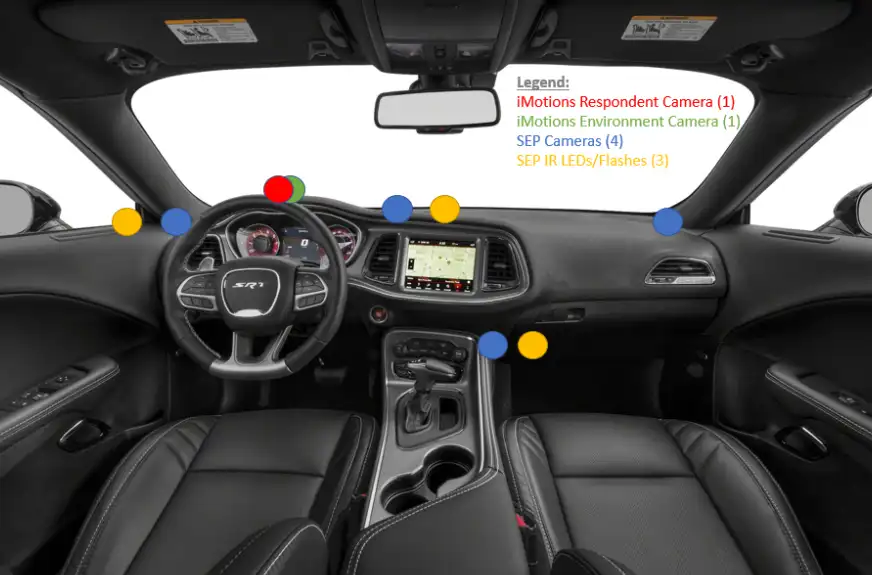Human-Machine Interface (HMI) design is a crucial aspect of the modern automotive design process. Through the use of biosensors, iMotions’ emotion analytics and Smart Eye’s eye-tracking technology redefine driver experience optimization. Learn how these advancements ensure interfaces are intuitive, safe, and tailored to human behavior for a seamless vehicle-user interaction.
Table of Contents
In automotive design, the integration of Human-Machine Interface (HMI) systems stands as a rapidly evolving testament to the evolution of vehicle-user interaction. The complexity of these systems necessitates a nuanced understanding of human factors engineering, ensuring that the driver’s experience is intuitive, safe, and efficient.
Companies like iMotions and its sister company Smart Eye are at the forefront of this innovation, leveraging their expertise in behavioral research and eye-tracking technologies to redefine HMI design principles.
The Role of Human Factors in HMI Design
Human factors in HMI design refer to the consideration of human capabilities and limitations in the context of interacting with automotive user interfaces, which essentially is everything the driver interacts with while driving.
This involves a delicate balance between ergonomic design, cognitive psychology, and user experience (UX) research to create interfaces that are not only user-friendly but also augment safety and performance all the while making the car intuitive and pleasant to operate. The goal is to design systems that align with natural human behaviors and cognitive processes to minimize the potential for errors and maximize usability. But what are the different aspects of Human factors when applied to an HMI design process?
Cognitive Load and Information Processing
One of the critical considerations in automotive HMI design is managing cognitive load in the driver – the amount of mental effort being used in the working memory. Human factors experts strive to design interfaces that facilitate easy information processing, minimizing cognitive load to prevent overload and confusion in order to prevent dangerous situations from arising.
This involves organizing information logically, avoiding unnecessary complexity, and leveraging visual and interactive hierarchies to prioritize critical functions. A good example of this is the various buttons on a steering wheel controlling a number of non-driving-critical operations, such as AC, music, cruise control, so that drivers can keep their eyes on the road while engaging with these features.

Ergonomics and Physical Interaction
Ergonomics plays a vital role in automotive HMI design, focusing on the physical interaction between the user and the interior of a car. This includes the placement of controls and displays, the physical effort required to operate them, and the feedback they provide. Good ergonomic design ensures that the interface can be used comfortably and efficiently, reducing the risk of physical strain, error or accidents.
User-Centered Design and Usability
At the heart of human factors is the principle of user-centered design – the process of involving users throughout the design and development phases to create more effective interfaces. This approach emphasizes usability, aiming to make systems easy to learn, efficient to use, and satisfying. User-centered design involves iterative testing with real users, allowing designers to refine the interface based on direct feedback and observations of user behavior.
Emotional and Psychological Considerations
Beyond cognitive and physical aspects, human factors in HMI design also consider the emotional and psychological impact of interfaces on users. This includes understanding how design elements can affect mood and stress levels, as well as designing interfaces that foster positive emotional connections with the user. For example, the use of color, shape, and texture can influence a user’s perception and emotional response to a system.
Safety and Accessibility
Safety is a paramount concern in HMI design, with human factors expertise being crucial in minimizing errors and accidents. This involves designing interfaces that are clear, predictable, and forgiving of user mistakes. Additionally, accessibility is a key aspect of human factors, ensuring that systems can be used by people with a wide range of abilities, including those with disabilities.
Emotion Analytics in HMI Design – The iMotions Way
As you might know, iMotions specializes in integrating emotion analytics into the automotive HMI design process. Their approach centers on understanding the emotional and cognitive states of drivers in real-time, leveraging advanced sensor technologies to capture data on eye movement, facial expressions, and physiological responses. This data-driven approach allows designers to identify how drivers interact with different HMI elements, pinpointing areas of cognitive overload, distraction, or stress.
By utilizing iMotions’ technology, automotive designers can make informed decisions about the layout, complexity, and functionality of HMI systems. For example, insights into gaze patterns can inform the optimal placement of critical information on dashboards, ensuring that drivers can access the information they need without diverting attention from the road. Similarly, monitoring physiological responses during interactions with infotainment systems can help in designing interfaces that minimize cognitive strain.
iMotions in Automotive Simulators
Integrating iMotions with automotive simulators marks a revolutionary step in enhancing the Human-Machine Interface (HMI) design process. This synergy allows for the creation of immersive, controlled environments where designers can experiment with and evaluate interface layouts, functionalities, and user interactions under realistic conditions.
By leveraging iMotions’ advanced emotion analytics and biometric sensing technologies within automotive simulators, researchers gain another layer of insights into the driver’s cognitive load, emotional states, and physiological responses to various HMI designs.
The application of iMotions Software in this context can involve a diverse range of biometric measurements such as; tracking eye movements, facial expressions, heart rate variability, and EEG readings among other metrics, to ascertain how drivers interact with and react to different interface elements during simulated driving tasks.
This real-time data provides a rich, nuanced understanding of driver behavior, enabling designers to identify which aspects of the HMI design facilitate intuitive use and which may cause confusion or distraction.

Furthermore, the feedback loop created by integrating iMotions with automotive simulators accelerates the HMI design iteration process. Designers can quickly prototype and test modifications, effectively using empirical evidence to guide the development of interfaces that are not only aesthetically pleasing but also optimize safety and user satisfaction.
This approach not only enhances the design process but also contributes to the creation of automotive interfaces that are more aligned with human capabilities and limitations, paving the way for safer, more intuitive driving experiences.
Human Factors in Automotive Human Machine Interface
Get an in-depth look at how iMotions is revolutionizing the automotive industry through advanced Human-Machine Interface (HMI) design research. Through iMotions’ collaboration with Smart Eye to integrate emotion analytics and eye-tracking technologies into the automotive design process, ensuring that vehicle interfaces are intuitive, safe, and tailored to enhance driver experience.

Smart Eye Pro: Pioneering Eye-Tracking Technology in Automotive HMI Design
Smart Eye’s contribution to HMI design lies in its advanced eye-tracking technology through their Smart Eye Pro system. The multi-camera system allows HMI designers and researchers to precisely track where and how long a driver looks at different parts of the vehicle interior, and how they engage with the cabin.
Smart Eye Pro provides invaluable insights into attention distribution and visual engagement. This technology is instrumental in developing adaptive HMI systems that can dynamically adjust based on the driver’s focus, enhancing both safety and user experience.

Synergizing Strengths for Future HMI Innovations
The strengths of iMotions and Smart Eye in emotion analytics and eye-tracking technology, respectively, offer the potential for synergy for the future of automotive HMI design. By combining these technologies, designers can gain a comprehensive understanding of the driver’s physical and emotional state, leading to the creation of HMIs that are not only more intuitive and engaging but also contribute to safer driving environments.
The Path Forward in HCI Design
As we move towards a future where vehicles become increasingly autonomous, the role of HMI design in ensuring seamless interaction between humans and machines becomes ever more critical. Technologies such as the ones provided by iMotions and Smart Eye, not only help in optimizing current designs but also lay the groundwork for the next generation of automotive interfaces, promising a future where vehicles are not just modes of transport but partners in enhancing human capability and safety on the road.
Read More about Human Factors and iMotions:
Human Factors Research Let human behavior drive innovation iMotions helps you examine the relationship between human beings and the systems they use, so that you can focus on improving effectiveness, optimizing ease of use, and minimizing user errors. From A/B and benchmark testing to experience measurement, we help you assess the effectiveness of any interface.

Eye Tracking Glasses
The Complete Pocket Guide
- 35 pages of comprehensive eye tracking material
- Technical overview of hardware
- Learn how to take your research to the next level












